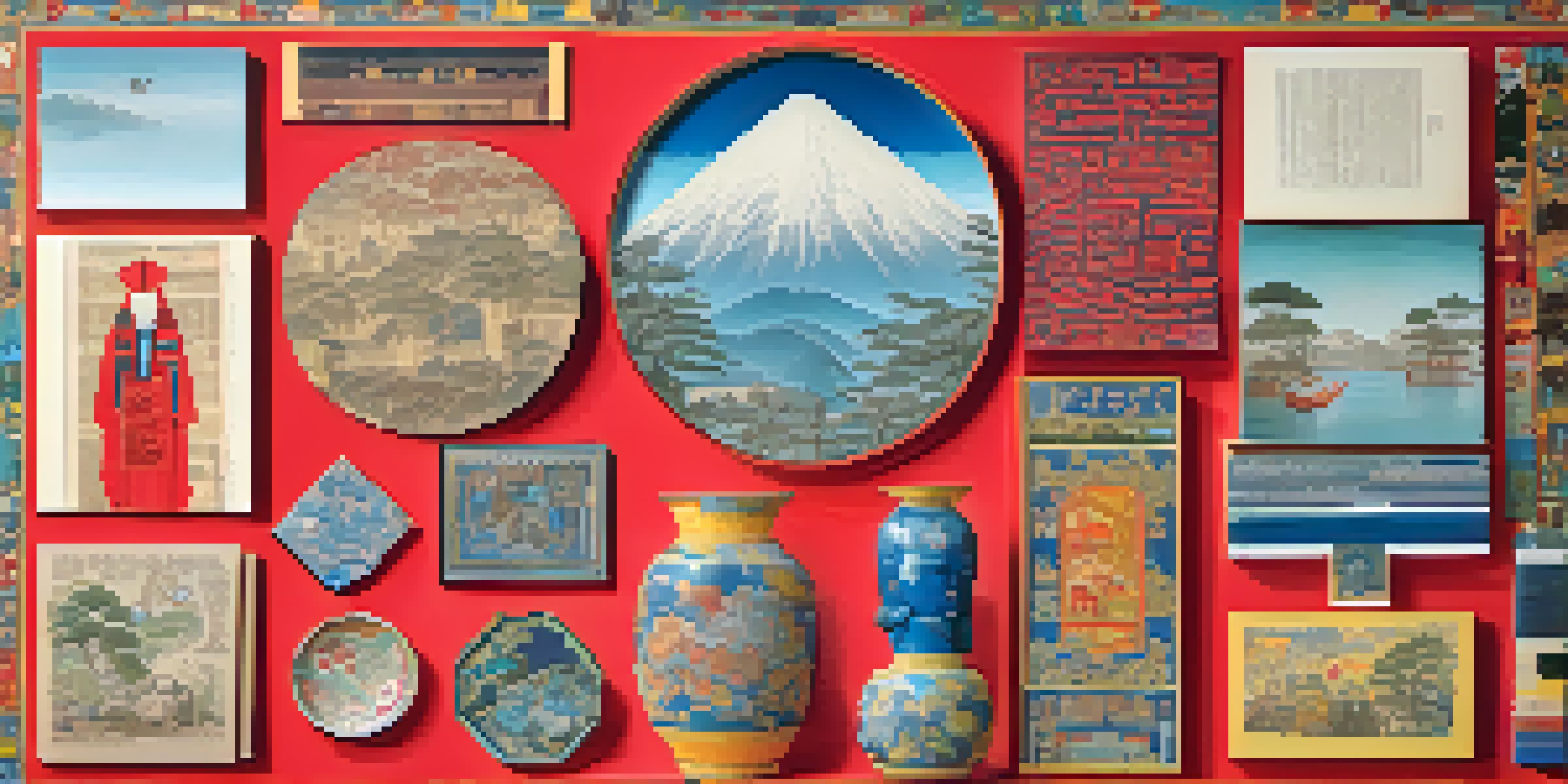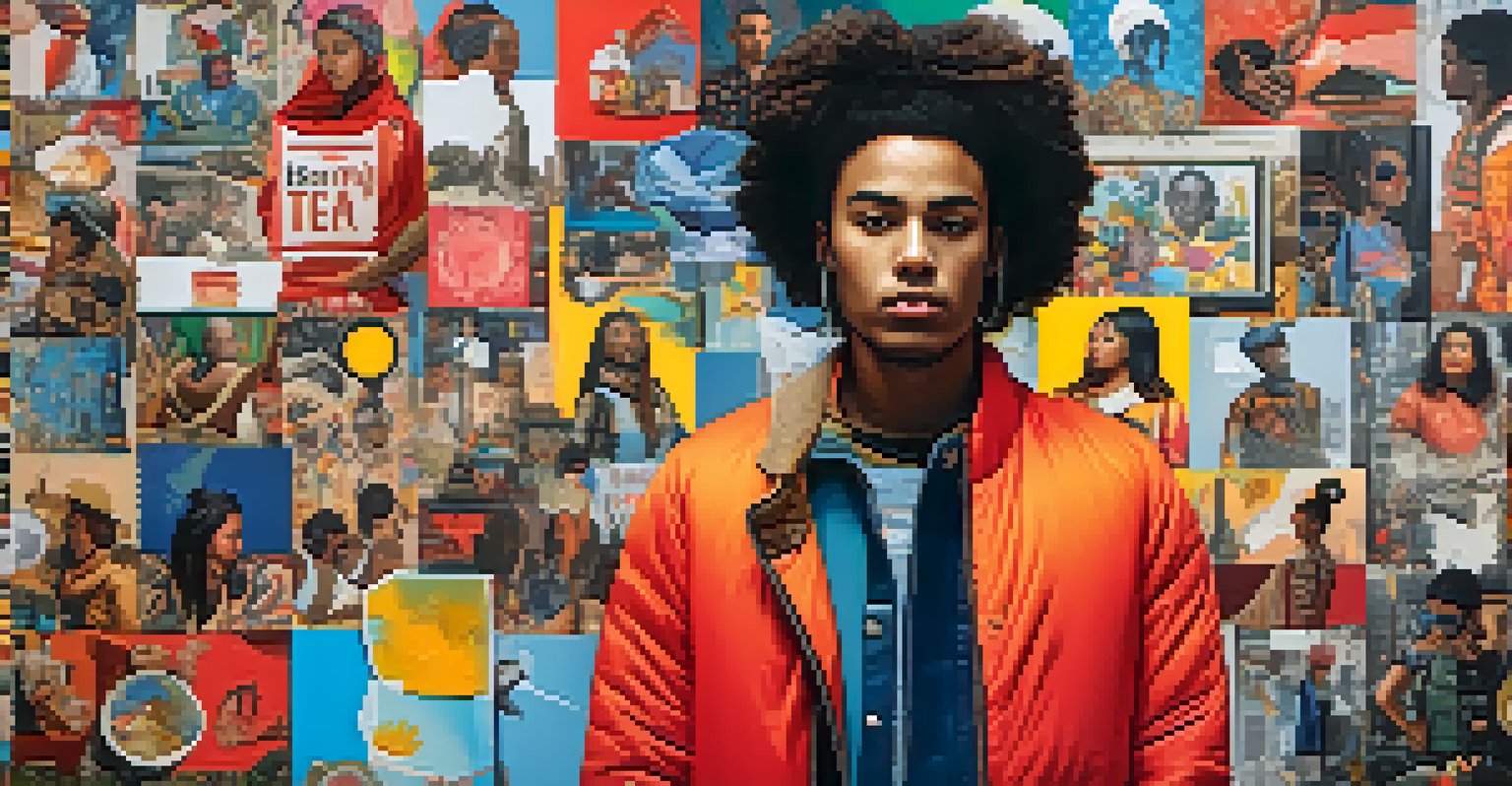The History of Collage Painting: An Artistic Evolution Journey

The Origins of Collage: A Glimpse into the Past
Collage painting traces its roots back to the early 20th century, but its essence can be found in ancient art forms. The term 'collage' comes from the French word 'coller,' meaning 'to glue.' Artists have been using materials like paper, fabric, and natural elements to create layered artworks for centuries, even if they didn't call it collage.
Collage is a way of putting things together that were never meant to be together.
One of the earliest forms of collage can be seen in the work of Chinese artists who used paper cutouts in their art. Similarly, Japanese artists employed a technique called 'kintsugi,' which involves repairing broken pottery with lacquer mixed with powdered gold, creating a new piece of art from the old. These practices laid the groundwork for what we now recognize as collage.
As we move into the 20th century, collage began to take on a more defined identity. Artists like Pablo Picasso and Georges Braque utilized collage techniques in their cubist works, bringing together different materials and textures to challenge traditional painting. This marked a significant turning point, showcasing how collage could redefine artistic expression.
The Rise of Dadaism: Collage as Political Statement
The Dada movement, which emerged in the early 1900s, introduced a new wave of artistic rebellion that heavily influenced collage painting. Dada artists sought to challenge societal norms and conventions through absurdity and spontaneity, using collage as a tool for their anti-establishment messages. This was a time when traditional art forms were being questioned and reimagined.

Dadaists like Hannah Höch utilized collage to critique the political climate of their time, especially regarding gender roles and war. By juxtaposing images from magazines and newspapers, they created thought-provoking pieces that encouraged viewers to question reality. Collage became not just an art form but a medium for social commentary.
Collage's Historical Roots
Collage has evolved from ancient art forms, with its origins traced back to early 20th-century artists who challenged traditional painting.
The Dada movement demonstrated that collage could transcend mere aesthetics, becoming a powerful voice for change. As artists began to see the potential of combining images and text, the canvas transformed into a platform for political expression, paving the way for future generations of artists.
Surrealism and Collage: Dreamlike Realities
Following Dada, the Surrealist movement of the 1920s took collage painting to new heights by exploring the subconscious mind. Artists like Max Ernst and Salvador Dalí embraced collage as a way to merge dreamlike imagery with reality, creating works that were both captivating and perplexing. Surrealism encouraged artists to tap into their imagination, breaking free from the constraints of reason.
The act of collaging is the act of selecting, arranging, and re-contextualizing, a way to create meaning from the chaos of images surrounding us.
Incorporating found objects and unexpected images, Surrealist collages often featured bizarre combinations that challenged perceptions. For instance, Ernst's 'The Eye of Silence' combined disparate elements to evoke a sense of mystery and intrigue. These collages invited viewers to interpret their meanings, making them active participants in the artistic experience.
The influence of Surrealism on collage painting was profound, encouraging artists to experiment with different techniques and themes. This movement underscored the idea that art could explore deeper psychological truths, leading to a rich tapestry of styles and approaches that continue to inspire artists today.
Modern Collage: A New Wave of Creativity
As we entered the late 20th century, collage painting evolved once again, embracing new technologies and materials. Modern artists began to incorporate digital elements, blending traditional techniques with digital media to create innovative works. This fusion opened up endless possibilities, allowing artists to explore new dimensions of collage.
Artists like David Hockney and Richard Hamilton utilized photography and digital manipulation to create vibrant collages that reflected contemporary life. Hockney's 'Joiners' series, for example, is a stunning example of how modern collage can capture moments in time, combining multiple images into a cohesive whole. This approach not only showcased creativity but also challenged the notion of a singular perspective.
Collage as Social Commentary
Movements like Dadaism and Surrealism showcased collage as a powerful medium for political and social critique, transforming it into a voice for change.
The rise of the internet and social media has further transformed the landscape of collage painting. Artists now have access to a vast array of images and ideas, allowing them to blend global influences into their work. This interconnectedness has fostered a thriving community of collage artists who continue to push the boundaries of what collage can be.
Collage in Contemporary Art: A Reflection of Society
In today's art world, collage painting serves as a mirror reflecting societal changes, cultural shifts, and personal narratives. Contemporary artists are using collage to address issues such as identity, politics, and the environment. This art form has become a powerful medium for storytelling, allowing artists to share their perspectives and experiences.
For instance, artists like Wangechi Mutu create collages that explore themes of femininity and race, merging elements from different cultures to construct new identities. Her work challenges viewers to confront preconceived notions, encouraging dialogue about representation and inclusivity in art. Such collages not only engage the audience but also provoke important conversations.
The evolution of collage in contemporary art highlights its adaptability and relevance in our rapidly changing world. As artists continue to experiment with this medium, they push the boundaries of creativity, demonstrating that collage is not just a technique but a dynamic form of expression that resonates with audiences today.
The Role of Technology in Collage Evolution
Technology has played a significant role in the evolution of collage painting, especially in the digital age. With the advent of graphic design software and online platforms, artists now have unprecedented access to tools that enable them to create complex collages with ease. This technological advancement has democratized the art-making process, allowing anyone with an internet connection to experiment with collage.
Digital collage offers a wealth of possibilities, from creating intricate compositions to manipulating images in ways that traditional methods cannot achieve. Artists can source images from around the globe, remixing and recontextualizing them to craft unique narratives. This fusion of technology and art has sparked a renaissance in collage painting, attracting a new generation of creators.
Modern Collage Embraces Technology
The integration of digital tools has revolutionized collage, enabling artists to explore new creative dimensions and engage with global influences.
However, the rise of digital collage also raises questions about authenticity and originality. As artists navigate this new landscape, they must find a balance between embracing technology while maintaining their unique voice. Ultimately, technology has enriched the world of collage, pushing the boundaries of creativity and inspiring fresh interpretations of this timeless art form.
The Future of Collage Painting: An Endless Journey
As we look ahead, the future of collage painting appears bright and full of potential. Artists are continuously exploring new materials, techniques, and themes, breathing new life into this age-old practice. Collage will likely continue to adapt, reflecting the ever-changing world around us and the diverse experiences of creators.
With the rise of environmental consciousness, many artists are now incorporating sustainable practices into their collage work. By using recycled materials and found objects, they not only create art but also promote awareness of environmental issues. This shift highlights how collage painting can serve as a platform for activism and change.

Ultimately, the journey of collage painting is an ongoing evolution. As artists push the boundaries of creativity and explore new ideas, they remind us that art is a living, breathing entity that reflects our collective experiences. The future holds endless possibilities, inviting both artists and audiences to engage with collage in new and exciting ways.